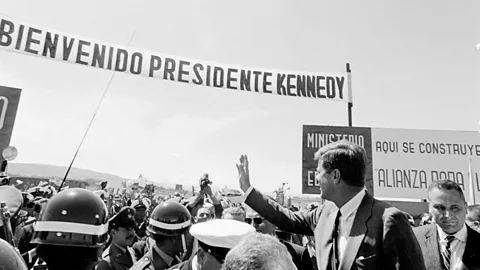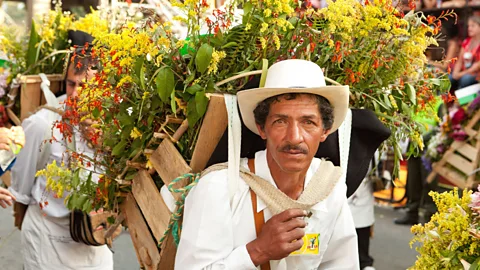The South American country supplying Mother's Day flowers
 Getty Images
Getty ImagesEvery May, millions of flowers make their way to mums across the US for Mother's Day, and the majority come from one nation.
So, where do these flowers come from?
That would be Colombia, which exports more than $2bn worth of cut flowers each year, making it the second-largest flower producer in the world after the Netherlands, and the largest single supplier to the United States. Nearly 80% of Colombia's flowers (or $1.62bn) end up in the US, so if you're Stateside, chances are that the stems in your Mother's Day bouquets originated in this South American country.
A 2024 article in the American Journal of Transportation noted that in just 21 days, more than 400 LATAM Airlines flights carrying 24,000 tonnes of flowers (roughly 552 million flower stems), took off from Colombia and neighbouring Ecuador. But thanks to rising inflation and US President Donald Trump issuing a 10% baseline tariff on most all imported goods from Colombia, many experts say that Mother's Day bouquets are likely to be more expensive in the US this year.
"Flowers are not something we can buy in advance and hold on to, they have to be cut fresh," shopping expert Trae Bodge recently told The Today Show. "Consumers are really going to feel that pinch when they're buying flowers [this year]."
Prior to the 1960s, most American bouquet-bound flowers were cut fresh in California, but they were expensive. Colombia's modern floral export industry traces its roots back to the Cold War. Then in 1961, US President John F Kennedy created the $100bn Alliance for Progress initiative, which aimed to combat the threat of communism by enhancing economic cooperation between the US and Latin America. Colombia became a key focus of the administration, and one of the programme's first tasks was to help Colombia develop its agricultural industry.
 Alamy
AlamyKennedy even visited Colombia's capital, Bogotá, in 1961, when nearly one-third of the city's 1.5 million people swarmed the streets to catch a glimpse of the US President and First Lady Jacqueline Kennedy Onassis. It was the largest reception JFK had while in office, and today, one of the city's densest neighbourhoods is still named Kennedy.
Things began to bloom in the 1970s when improvements in air transportation made it easier to connect Colombia's fertile soil with the booming demand for flowers in the US and abroad. Entrepreneur and floriculture hobbyist Edgar Wells, whose export company sent the first shipment of cut flowers from Bogota to Miami in 1965, once compared Colombia's flower industry to the mythical legend of El Dorado, saying: "After 400 years, the true riches of El Dorado have been discovered … a permanent source of riches for all Colombians, for all time."
In 1991, the industry got an additional boost with the passage of the Andean Trade Preference Act (ATPA), which offered many South American countries a way to import a wide variety of goods duty-free, including flowers. The country now exports billions of flowers to the US every year, and despite problematic labour practices and a dwindling work force, it still specialises in growing some of the most popular flowers found in bouquets or given as gifts – including roses, carnations and orchids.
The impressive breadth of flowers grown in Colombia is partly due to the country's unique landscapes. The countryside surrounding city of Facatativá, outside of Bogota, is a hotspot for flower farms. The area's setting on a high plain savanna in the shadow of the Andes mountains makes an ideal space for flower growing, with more than 73% of Colombia's floral production taking place there. Further north, the area around Medellín accounts for an additional 24%.
 Alamy
AlamySince 1957, Medellín has celebrated its growing floral heritage with the annual Feria de las Flores (Flower Festival), which is now the biggest cultural event in the city. Known as the "city of eternal spring" because of its beautiful year-round weather, Medellín explodes with colour every August as the 10-day flower festival kicks off. The event, which takes place in downtown Medellín, features food, artists, vendors and – of course – flowers.
The festival is best known for the elaborate silleteros parade. The term silleteros, or "saddle men", refers to the practice of men carrying goods on large circular plates worn on their backs. The tradition started as a way to transport produce, goods and even people through the mountainous terrain of the Andes, however it has become synonymous with flower sellers in Colombia because of the use of these back plates to transport flowers from farms in the mountains to the cities where they're sold.
During the flower festival, silleteros create elaborate artistic floral arrangements, which often depict important historical and cultural moments with flowers and carry them through the streets on these traditional plates.
A more common, but no less beautiful, way to experience Colombia's floral heritage is by visiting one of the many flower markets in cities around the country. For example, one of Medellín’s famous farmers' markets, the Placita de Flóres sells locally grown flowers alongside other goods and produce, as does the Mercado de Paloquemao in Bogotá. Some flower farms, also welcome guests, so that visitors can see exactly where their favourite blooms originate, while also directly supporting the people who grow them.
This article was originally published in 2024 and has since been updated.
--
If you liked this story, sign up for The Essential List newsletter – a handpicked selection of features, videos and can't-miss news, delivered to your inbox twice a week.
